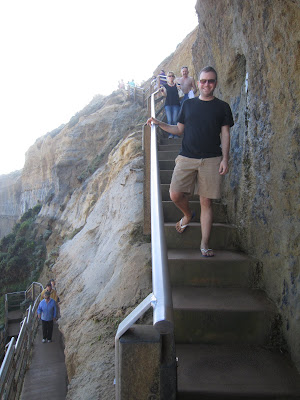I was super excited for the last destination on our big road trip: Melbourne! Australia’s second largest city, Melbourne is the main rival to Sydney. Sydneysiders tend to dislike Melbourne, but everyone else in the world seems to love it. From what I heard in advance, I had a feeling that I was going to love it too.
At first glance, Melbourne doesn’t really compare to Sydney at all. The natural beauty of Sydney – the beaches, the ocean, the sun, and especially the harbour – just aren’t anywhere to be found in Melbourne. There is one beach in a neighbourhood called St. Kilda, but it’s pretty dismal. The weather changes on a dime – warm and sunny one minute, wet and gross the next. And driving is nightmarish. The city streets are shared between cars and trams, and right turns seem to be prohibited everywhere I want to make a right turn. Also, left turns are prohibited everywhere I want to make a left turn. Then there are the hook turns. Hook turns are where go to the far left side of the street (keep in mind Australia drives on the left), then you gently stick into the intersection and wait for a yellow or red light. Then you proceed to turn… wait for it… right. Right. All the way across the intersection. They do it to avoid trams, but it really doesn’t make any sense. Why don’t they just paint a right turn lane next to the tracks? Needless to say, I used the “go one extra block and make a series of three left turns to avoid getting killed making one right hook turn” method. I survived. It worked. My first impression of Melbourne was not good.
But then, just as quickly as the Melbourne weather changes, my impression changed too. After the initial shock of driving wore off, we left the hotel and walked around the city. The architecture was… stunning – and some places looked like you were in Europe. There are laneways (alleys) littered with bars and restaurants. I like bars. I like restaurants. And the quality was… well, incomparable to Sydney.
Sydney bars tend to be too crowded, too pretentious, or too full of bogans (rednecks) – or any combination of the three. With the exception of the Shady Pines Saloon (a country-western themed bar in my neighbourhood), there really aren’t any bars that stand out in Sydney. In Melbourne, on the other hand, the two bars we went to were both fabulous. One featured a giant giraffe and giant ostrich when we walked in – with other giant random animals scattered about (not real animals, of course), and the crowd was fully mixed: suits, preps, hipsters, creepy dreadlock people, normal folk (like me!), and every other group of people you can imagine. The next night I was taken up to a rooftop bar with a view of the entire city. Again, a mixed crowd and 100% unpretentious. Love it.
But, you know me, and you know there’s one thing that really makes it or breaks it for me: the food. Please, allow me to ring the bell and declare a win. The food was great – from the laneway cafes to the Ethiopian restaurant (I finally got to quench my craving!), to the cute little brunch spot in St. Kilda, everything just tasted delicious. And the cherry on top: the brunch spot in St. Kilda even had cute baristas. Win win win!
No wonder this place is one of the most livable cities in the world. Please remind me why I moved to Sydney again? I popped into my company’s Melbourne office to introduce myself to the team down there… just in case I want to move to Melbourne one day. But until that day, I’ll have to settle for the random weekend getaway. And the first one of those will be… in a week and a half. Woohoo!
I didn’t take too many photos – mainly because I was busy eating and looking at all the cool buildings – but here is a smattering of shots that I managed to snap, and I promise to do a better job on the next trip.
Views of the city taken from St. Kilda:
The Melbourne Museum:
Yay! The King Tut exhibit is in town!
Cleopatra ?
Carlton Gardens. Tell me this doesn’t look like Europe.
Look – a rainbow behind the fountain! But where are the gays?
There I am!
Melbourne Charlotte (not to be confused with Sydney Charlotte or Charlotte from Sex & the City) with messy fingers from a mostly finished plate of Ethiopian food. Yummilicious.
St. Kilda Beach. It’s a beach, yes, but it’s no Sydney beach.
But it does have penguins! Yay! I finally got a chance to snap a photo of a real live penguin! (I turned the flash off, of course.)
And did I mention I drove by a Costco??? Yes – they have a Costco in Melbourne! And soon to be one in Sydney too! But until that opens, I’ll drive by again each trip to Melbourne to take in the view. I miss Costco.





























































